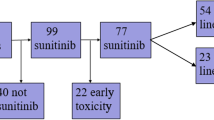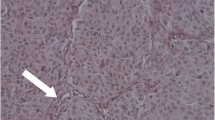Abstract
Background
Endoglin/CD105 is a transmembrane regulatory receptor for transforming growth factor-β (TGF-β) that is predominantly expressed on proliferating endothelial cells (ECs) in culture and on angiogenic blood vessels in vivo. Endoglin has been associated with angiogenesis and prognosis in several malignancies. Although microvascular structure has been characterized by a variety of different other endothelial markers so far, there is no consensus on the prognostic value of microvessel quantification in uveal melanoma due to differences in tissue pretreatment, variability in the reactivity of endothelial cell markers, blood vessel counting methods, and vasculogenic mimicry by melanoma cells expressing endothelial cell markers. The aim of this study was to investigate the expression pattern of endoglin and to evaluate whether proliferative activity of ECs determines the clinical prognosis of uveal melanoma.
Methods
Paraffin sections from 35 clinicopathologically well-characterized cases of primary uveal melanomas were stained for Ki-67, von Willebrand factor (vWF) and endoglin. In 16 cases, metastatic disease led to death. The mean follow-up of the nonmetastasized cases was 10.6 (9–13) years. The immunohistological specimens were evaluated by three independent observers who were masked to the follow-up of patients. Statistical analyzes included Kaplan-Meier survival curves and the fitting of log-rank and Wilcoxon test models.
Results
Immunohistochemistry with vWF confirmed that all examined specimens were vascularized. Expression of Ki-67 could be found in 26 (74%) of the samples. Moderate to high expression of endoglin was found in 13 cases (37%). Kaplan-Meier analysis showed a significant association (p<0.001) between an enhanced endoglin expression and death due to metastatic uveal melanoma.
Conclusions
The study demonstrates for the first time that the expression of endoglin can be used as a specific marker for angiogenesis in uveal melanomas. Thus, differentiation between the quiescent and proliferating ECs enables the location and characterization of hot spots of angiogenesis in melanomas. The data suggest not only a prognostic relevance in individual patients but promise applications in assessing the efficacy of antiangiogenic agents.


Similar content being viewed by others

References
Altamente M, Montagner R, Fonsatti E, Coalizzi F, Cattarossi I, Brasoveanu LI, Nicotra MR, Cattelan A, Natali PG, Maio M (1996) Expression and structural features of endoglin (CD105), a transforming growth factor b1 and b3 binding protein, in human melanoma. Br J Cancer 74:1586–1591
Barbara NP, Wrana JL, Letarte M (1999) Endoglin is an accessory protein that interacts with the signaling receptor complex of multiple members of the transforming growth factor-β superfamily. J Biol Chem 274:584–594
Barbareschi M, Weidner N, Gasparini G, Morelli L, Forti S, Eccher C, Fina P, Caffo O, Leopardi E, Mari F, Bevilacqua P, Dalla Palma P (1995) Appl Immunochem 3:75–84
Bodey B, Bodey B Jr, Siegel SE, Kaiser HE (1998) Immunocytochemical detection of endoglin is indicative of angiogenesis in malignant melanoma. Anticancer Res 18:2701–2710
Bosari S, Lee AK, DeLellis RA, Wiley BD, Heatley GJ, Silverman ML (1992) Microvessel quantitation and prognosis in invasive breast carcinoma. Hum Pathol 23:755–761
Buhring HJ, Muller CA, Letarte M, Gougos A, Saalmuller A, van Agthoven AJ, Busch FW (1991) Endoglin is expressed on a subpopulation of immature erythroid cells of normal human bone marrow. Leukemia 5:841–847
Chang YS, Di Tomaso E, McDonald EM, Jones R, Jain RK, Munn LL (2000) Mosaic blood vessels in tumors: frequency of cancer cells in contact with flowing blood. Proc Natl Acad Sci 97:14608–14613
Chen X, Maniotis AJ, Majumdar D, Pe'er J, Folberg R (2002) Uveal melanoma cell staining for CD34 and assessment of tumour vascularity. Investig Ophthalmol Vis Sci 43:2533–2539
Dales JP, Garcia S, Carpentier S, Andrac L, Ramuz O, Lavaut MN, Allasia C, Bonnier P, Taranger-Charpin C (2004) Prediction of metastasis risk using VEGF-R1, VEGF-R2, Tie-2/Tek and CD105 expression in breast cancer. Br J Cancer 90:1216–1221
Dawn G, MacKie RM (2002) Expression of endoglin in human melanocytic lesion. Clin Exp Derm 27:153–156
Derbyshire E, Thrope P (1997) Targeting the tumour endothelium using specific antibodies. In: Bicknell R, Lewis C, Ferrara N (eds) Tumour angiogenesis. Oxford University Press, Oxford, pp 343–356
Derrynk R, Feng XH (1997) TGF-beta receptor signaling. Biochim Biophys Acta 1333:105–150
Edel M, Robbins P, D'Antuono M, Harvey J, Papadimitrion J, Mitchell C, Dawkins H (2000) Assessment of endothelial cell proliferation in primary breast carcinoma and its association with axillary lymph node status. Breast 9:28–34
Fleiss JL (1971) Measuring scale agreement among many raters. Psychol Bull 76:378–382
Folberg R, Rummelt V, Parys-van Ginderdeuren R, Hwang T, Woolson RF, Pe'er J, Gruman LM (1993) The prognostic value of tumour blood vessel morphology in primary uveal melanoma. Ophthalmol 1993:1389–1398
Folberg R (1997) Discussion of paper by Foss et al. Br J Ophthalmol 81:247–248
Folberg R, Maniotis AJ (2004) Vasculogenic mimicry. APMIS 112:508–525
Folkman J (1971) Tumour angiogenesis: therapeutic implications. N Engl J Med 285:1182–1186
Fonsatti E, Maio M (2004) Highlights on endoglin (CD105); form basic findings towards clinical applications in human cancer. J Transl Med 2:18–24
Foss AJE, Alexander RA, Jefferies LW, Hungerford JL, Harris AL, Lightman S (1996) Microvessel count predicts survival in uveal melanoma. Cancer Res 56:2900–2903
Fox SB, Harris AL (2004) Histological quantification of tumour angiogenesis. APMIS 112:413–430
Gougos A, Letarte M (1988) Identification of a human endothelial cell antigen with monoclonal antibody 44G4 produced against a pre-B leukemic cell line. J Immunol 141:1925–1933
Gougos A, LeTarte M (1990) Primary structure of endoglin, an RGD-containing glycoprotein of human endothelial cells. J Biol Chem 265:8361–8364
Griffioen AW, Damen CA, Blijham GH, Groenewegen G (1996) Endoglin/CD105 may not be an optional tumour endothelial treatment target. Breast Cancer Res Treat 39:239–240
Grisanti S, Canbek S, Kaiserling E, Adam A, Lafaut B, Gelisken F, Szurman P, Henke-Fahle S, Oficjalska-Mlynczak J, Bartz-Schmidt KU (2004) Expression of endoglin in choroidal neovascularization. Exp Eye Res 78:207–213
Hoang MP, Selim MA, Bentley RC, Burchette JL, Shea CR (2001) CD34 expression in desmoplastic melanoma. J Cutan Pathol 28:508–512
Kumar S, Wang JM, Bernabeu C (1996) CD 105 and angiogenesis. J Pathol 178:363–366
Letarte M, Greaves A, Vera S (1995) CD105 (endoglin). In: Schlossman SF, Baumsell L, Gilks W (eds) Leukocyte typing. Oxford University Press, Oxford, pp. 1756–1759
Lane AM, Egan KM, Yang J, Saornil MA, Alroy J, Albert D, Gragoudas ES (1997) An evaluation of tumour vascularity as a prognostic indicator in uveal melanoma. Melanoma Res 7:237–242
Li C, Gardy R, Seon BK, Duff SE, Abdalla S, Renehan A, O'Dwyer ST, Haboubi N, Kumar S (2003) Both high intratumoural microvessel density determined using CD105 in colorectal cancer patients correlate with poor prognosis. Br J Cancer 88:1424–1431
Mäkitie T, Summanen P, Tarkkanen A, Kivelä T (1999) Microvascular density in predicting survival of patients with choroidal and ciliary body melanoma. Investig Ophthalmol Vis Sci 40:2471–2480
McDonald DM, Munn L, Jain RK (2000) Vasculogenic mimicry: how convincing, how novel and how significant? Am J Pathol 156:383–388
Pezzella F (2000) Evidence for novel non-angiogenic pathway in breast-cancer metastasis. Lancet 355:17878
Risau W (1995) Differentiation of endothelium. FASEB J 9:926–933
Salvesen HB, Gulluoglu MG, Stefansson I, Akslen LA (2003) Significance of CD105 expression for tumour Angiogenesis and prognosis in endometrial carcinoma. APMIS 111:1011–1018
Schaling DF, Van der Pol JP, Schlingemann RO, Parys-van Ginderdeuren R et al (1999) Vascular density and vascular patterns in the prognosis of choroidal melanoma. In: Schaling DF (ed) Radionuclides and radiolabeled antibodies in choroidal melanoma (diagnosis and therapy). Rijksuniversiteit te Leiden, Leiden, pp. 43–54
Seftor EA, Meltzer PS, Schatteman GC, Gruman LM, Hess AR, Kirschmann DA, Seftor REB, Hendrix MJC (2002) Expression of multiple molecular phenotypes by aggressive melanoma tumour cells: role in vasculogenic mimicry. Crit Rev Onc 44:17–27
Seon BK, Matsuno F, Haruta Y, Kondo M, Bareas M (1997) Long-lasting complete inhibition of human solid tumours in SCID mice by targeting endothelial cells of tumour vasculature with antihuman endoglin immunotoxin. Clin Cancer Res 3:1031–1044
Tanaka F, Otake Y, Yanagihara K, Kawano Y, Miyahara R, Li M, Yamada T, Hanaoka N, Inui K, Wada H (2001) Evaluation of Angiogenesis in non-small cell lung-cancer: comparison between anti-CD34 antibody and anti-CD 105 antibody. Clin Cancer Res 7:3410–3415
Thorpe PE, Burrows FJ (1995) Antibody-directed targeting of the vasculature of solid tumours. Breast Cancer Res Treat 36:237–251
Wikstrom P, Lissbrant IF, Stattin P, Egevad L, Bergh A (2002) Endoglin is expressed on immature blood vessels and is a marker for survival in prostate cancer. Prostate 51:268–275
Wrana JL, Attisano L, Wieser R, Ventura F, Massagué J (1994). Mechanism of activation of the TGF-β receptor. Nature 370:341–347
Author information
Authors and Affiliations
Corresponding author
Rights and permissions
About this article
Cite this article
Ziemssen, F., Wegner, R., Wegner, J. et al. Analysis of neovasculature in uveal melanoma by targeting the TGFβ-binding receptor endoglin: is there prognostic relevance of proliferating endothelium?. Graefe's Arch Clin Exp Ophthalmo 244, 1124–1131 (2006). https://doi.org/10.1007/s00417-005-0135-z
Received:
Revised:
Accepted:
Published:
Issue Date:
DOI: https://doi.org/10.1007/s00417-005-0135-z



